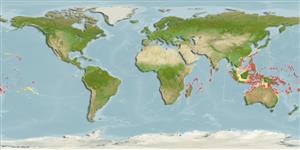Classification / Names
Common names from other countries
Main reference
Size / Weight / Age
Max length : 9.0 cm TL male/unsexed; (Ref. 559)
Environment
Marine; reef-associated; non-migratory; depth range 2 - 40 m (Ref. 1602), usually 10 - 25 m (Ref. 5439)
Climate / Range
Tropical, preferred ?; 35°N - 30°S
Distribution
Western Pacific: Christmas Island and the northwest shelf reefs of Australia in the eastern Indian Ocean to Kiribati, north to southern Japan. Recently reported from Tonga (Ref. 53797).
Countries | FAO areas | Ecosystems | Occurrences | Introductions
Short description
Dorsal
spines
(total): 12;
Dorsal
soft rays
(total): 12;
Anal
spines: 2;
Anal
soft rays: 12. Body orangish brown with faint light bluish to lavender iridescence on lower head and thorax; darkly-edged orbit; iris yellowish with a blackish blotch dorsally and ventrally. Eyes large. Preopercular margin smooth. Blackish spot on dorsal and anal fins confined at rear base; upper and lower edges of caudal peduncle and fin blackish; wedge-shaped black spot on pectoral base. With prominent pores of lateralis system on head (Ref. 2693). Body depth 1.7-2.0 in SL (Ref. 90102).
IUCN Red List Status (Ref. 115185)
Threat to humans
Harmless
Human uses
Aquarium: commercial
More information
ReferencesAquacultureAquaculture profileStrainsGeneticsAllele frequenciesHeritabilityDiseasesProcessingMass conversion
Tools
Special reports
Download XML
Internet sources
Estimates of some properties based on models
Phylogenetic diversity index
PD50 = 0.5000 many relatives (e.g. carps) 0.5 - 2.0 few relatives (e.g. lungfishes)
Trophic Level
2.6 ±0.29 se; Based on food items.
Resilience
High, minimum population doubling time less than 15 months (Preliminary K or Fecundity.)
Vulnerability
Low vulnerability (19 of 100)
Price category
